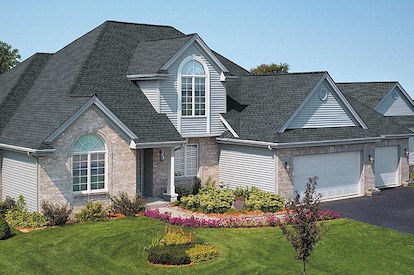
In Your Community
How GAF's Co-Op Program Makes a Difference in Students' Lives
As part of its effort to build resilient communities, GAF provides students across the country with opportunities to gain work experience and hands-on training. The GAF co-op program offers participants autonomy and leadership in project management, engineering design, budgeting, project installation, and more.Over the years, the GAF co-op recruiting program has helped students advance academically, grow professionally, and earn competitively while working full time with North America's largest roofing and waterproofing manufacturer.How the GAF Co-Op Program WorksThe program gives students high-impact, hands-on experience in the manufacturing sector. They perform meaningful work alongside supportive GAF mentors and senior leadership while earning a competitive wage. Participants can also receive credits from their university, which they can apply to their coursework.Differences between a Co-op and an InternshipInternships and co-ops have a few notable differences. At GAF, the main difference is the length of time. Internships at GAF usually last 10 weeks, but the co-op program is six months. While internship programs often allow students to stay enrolled in school and complete coursework as they gain professional training, co-op participants must take a semester off to gain full-time work experience.Not all companies pay internship participants for their work. However, at GAF, both interns and co-op students are paid competitive hourly wages. GAF also offers financial relocation assistance for qualifying co-op program candidates.Finally, participants in the GAF programs are there to learn real skills that will help them advance their future careers. GAF interns and co-op students are given the same responsibilities, and chances to collaborate on major projects, as full-time employees.Recent GAF Co-Op Success StoriesMin U, a mechanical engineering student at the University of Maryland, says he "fell in love with manufacturing" thanks to his placement on an engineering project. The experience gave him a firsthand account of the role engineering plays in manufacturing safety, profit, and operations. This ultimately led him to shift his career goals from construction management to manufacturing engineering.When Dante Stellar, an industrial engineering student at Virginia Tech, met GAF representatives at a career fair, he says he didn't expect to become a self-proclaimed "nerd for shingles" and develop a passion for manufacturing. However, that's exactly what happened. And that newfound passion paid off when Dante won Student of the Year from Virginia Tech's Cooperative Education and Internship Program. Dante notes he's now eager to return to GAF and aspires to become a manufacturing leader in the world of shingles.Michael Hesseltine, an electrical engineering student at Texas A&M University, chanced upon a GAF co-op recruiting listing online. After a series of interviews, he landed a project engineering co-op in Ennis, Texas. Working with the Ennis team on major projects solidified his manufacturing engineer career goals.Co-Op Students Complete Meaningful WorkStudents in the GAF co-op program are involved in meaningful projects and get to see their work's impact on day-to-day operations.During his time in Ennis, Michael designed a baler that compacts fiberglass scrap, reducing site disposal trips and costs. He also oversaw renovations of the site's maintenance mechanical break room from start to finish. He notes that his favorite contribution was helping design the electrical system for a dewatering press.In Baltimore, Min's core project was ensuring site compliance with state regulations for discharging stormwater runoff. Min managed all the project contractors and budget with his manager's and mentor's support. Throughout his time there, Min was exposed to Lean methodologies, 5S, risk mitigation, insurance compliance, cost control, and procedure standardization. He gained an overall understanding of manufacturing equipment and business.At the Tampa plant, Dante worked on a rock pad storage expansion project and installed a starwheel machine guarding the manufacturing line, among other important projects. According to Dante, the defining moment of his co-op experience was his granule silo refurbishment project, which involved replacing eight silos, including floor plates and support beams.Dante explains the trust and opportunities his mentors provided were key to his success. "At GAF, I was given the chance to interact with contractors, and immerse myself in the plant, which accelerated my learning," he says.Co-Op Students Build Professional RelationshipsThrough "lunch and learn" sessions, leadership speaker series, meetings with senior leadership, and mentorship, co-op students build long-term professional relationships.Dante was given the chance to showcase the coordination and safety efforts involved in his granule silo project to the GAF executive leadership team in Parsippany, New Jersey.For Min, getting the right feedback to grow meant having the right relationships. He notes the mentorship from his manager Alex Smith and engineering manager Mike Kloda was key to his progression. As advice to future co-op participants, he explains that "everyone is here to help... but it's up to you to drive that forward."Meanwhile, the autonomy and leadership opportunities program leaders gave Michael allowed him to grow technically and professionally. "I was often the go-to person for projects, managing contractors and ensuring everything was on track," he says.Joining an Industry Filled with OpportunityThe GAF co-op program helped Min, Michael, and Dante start and solidify their careers in manufacturing engineering. Following their experience, each student was excited and motivated by the autonomy, responsibility, and growth opportunities they were given. In fact, Min has since accepted a full-time role as a project engineer at the GAF plant in Baltimore. His expected start date is July 7, 2025.GAF is committed to fostering diversity, equity, and inclusion throughout the organization. It believes a talented and diverse organization can drive innovation, growth, and transformation more effectively. To further bolster inclusivity, GAF offers academic and merit scholarships, partners with the Thurgood Marshall College Fund to recruit from the nation's most diverse talent at Historically Black Colleges and Universities and Predominantly Black Institutions, and reaches out to candidates at career fairs nationwide.Bright and motivated minds who want to explore manufacturing have plenty of opportunities. From shingles to solar to environmental impact, GAF offers many exciting career paths.Are you ready to do work that matters and be empowered to explore a leadership role? Discover the co-ops, internships, and job opportunities available at GAF.
By Authors Annie Crawford
October 11, 2024



